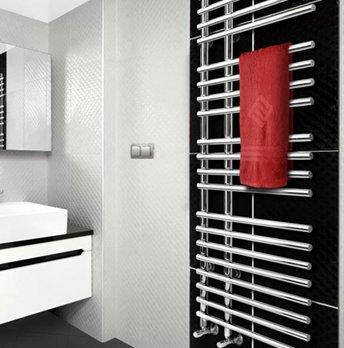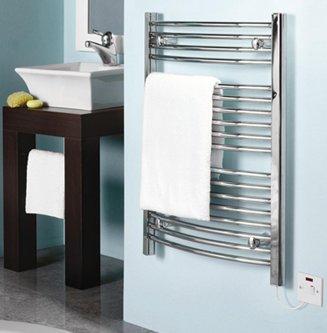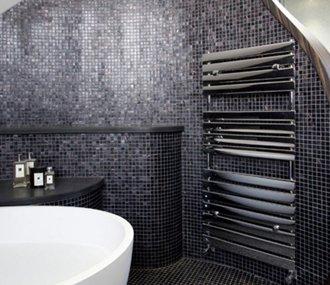The heated towel rail is a fairly popular device for the bathroom. He dries towels, expels excessive moisture from the room after bath procedures. In addition, it heats up the bathroom to keep the user warm. However, despite the ease of assembly, the cost of dryers is impressive. It's a shame to spend tens of thousands of rubles on a device that does not meet the buyer's expectations. To know which heated towel rail to choose, you need to read the recommendations.
Content
The principle of operation and the device of heated towel rails
In fact, every heated towel rail is a radiator. Its functions also include drying an excessively humid room. Regardless of the type, it is a coil pipe through which the working fluid will circulate.
The loan is all determined by the type of device. When it is a water device, fittings are supplied with it in order to connect to the heating system, when the electric is an internal heating element with its own cord and plug.
The principle of operation of such a device is simple: during heating (due to the increased temperature indicators of the internal heat carrier), the pipes will evaporate moisture from the things hung out and dry the air in the room. Basically, such a "battery" is fixed on the wall, but there are also floor products.
Heated towel rail selection parameters
The choice of a heated towel rail is a responsible task. In order to avoid mistakes during the selection, to buy the necessary product, you need to familiarize yourself with all the nuances of installation, technical characteristics and features of the use of such devices.
Manufacturing material

Of course, when choosing a water heated towel rail, you will need to consider the materials used in the main system. It is not recommended to combine different metals with each other. However, it is extremely important to know the characteristics of any heated towel rails:
- Chermet. Ordinary painted steel that is able to withstand the pressure in an individual heating system. For centralized it is also suitable, but only when there is no more than 6 atmospheres in the pipes. Such devices are not characterized by the best thermal conductivity, and over time they will rust and leak. Differ in budgetary cost.
- Stainless steel. Such devices have an all-welded construction and are not afraid of rust. But the seams directly on stainless steel are considered a weak link, since it is technically extremely difficult to achieve a reliable tight connection in this metal. The mass of such a device, as in ordinary steel, is only several times higher.
- Copper. Fittings made of the metal in question are the best for connection to the water circuit.They can easily withstand the increased pressure in the system and hydraulic shocks, are characterized by an anti-corrosion effect and look great in the interior. Copper products are versatile, have low weight and good heat transfer. However, they are expensive.
- Brass. It is characterized by the same advantages as pure copper, in addition to the main thing - it is not designed for increased pressure in pipes. It is optimal to connect brass devices to an individual heating system or use electric models.
The form
In addition to the standard coil-shaped towel rails, the developers create new configurations of these devices, trying to surprise and lure customers. Such a variety makes it possible to select a model for every taste and for a different interior of a bathroom or other room. Among the large assortment, it is possible to find such forms:
- E-shaped. It looks neat, stylish and modern, without unnecessary things.
- U-shaped. Perfect for a minimalist style, it looks unobtrusive, stylish, and will not take up a large area.
- M-shaped. Reminds of a snake, similar to those dryers that were previously installed in multi-storey buildings.
- "Snake". It will be especially interesting to look at the dark wall decoration, it is considered a multifunctional and decorative accessory of the bathroom.
- "Ladder". Perhaps called the most common solution, since it can be found more often in interiors. Such devices are produced in water, electrical and combined variations, therefore they can be purchased both for the bathroom and for the hallway or bedrooms.
- Dryer with shelf built into 1 of the parts. Comfortable in that it is possible to hang or put things on such a protruding lattice element, around which air circulates freely, which will make it possible to dry out much faster. In addition, it is possible to store clean, dried towels on the top shelf, which will be warm and pleasant at the end of the bath procedures.
Other forms are known, more complex, but their basis is simple, the above-mentioned configurations.
Power (for electrical products)
The drying rate of things will depend on the performance of the dryer, as well as the temperature indicators in the room.
To maintain it at +25 degrees, it is required that 1 sq. m area accounted for approximately 140 W of heat. It is necessary to take into account other devices of the heating system that are present in the bathroom - they also take part in the calculation.
Connection method (for water and universal products)
Like heating radiators, dryers can be connected to the hot branch in different ways. The effectiveness of its functioning, the degree of return of the body depends on this. The following connection methods are distinguished:
- Lower. The entrance and exit are located at the bottom. Quite an effective method, since hot water is immediately forced into the top of the coil and passes through the pipe, giving off heat.
- Top. The inlet and outlet connections are at the top. Such an assembly is ineffective, since the lower part of the device remains cold all the time, and it will be difficult for a cooled heat carrier to rise to the exit hole.
- Diagonal. An excellent solution, in particular when the liquid comes from the upper corner, and is removed from the opposite one at the bottom, giving the maximum amount of heat to the room.
- Lateral. A common solution where feeding is from top to bottom, however, each nozzle is located on 1 side of the dryer. Such a design will make it possible to install the device in any part of the room.
Installation location
The design of the dryer mounts is mostly determined by the possibility of its installation and the space occupied by it. For this indicator, devices are divided into:
- Wall mounted. The most common products that save significant indoor space.
- Outdoor.A little more massive and, due to the peculiarities of installation, they take part of the area. When the user has a fairly spacious room, such a device will be a good zoning element.
- Folding. It is one of the modifications of wall dryers, with the difference that it rotates 180 degrees around the axis. Such a model does not differ in the duration of operation - gaskets often leak at the bend.
- Portable. It is one of the modifications of the electric heated towel rail. Since it only requires an outlet to function, the device can be easily carried and used in other rooms.
Design styles
In addition to the variety of forms, it should be noted the main design directions in which it is customary to design modern dryers. The choice according to this criterion should be made taking into account the general interior of the room where the device is installed. On the modern market, you can find the following series in an extensive range:
- Premium. Premium products are designed for installation in a bathroom that is designed in a variety of styles, as it has a variety of shapes and finishes. Such products are made of quality materials, they are distinguished by their impeccable appearance and design. They are intended for drying wet towels, as well as for decorating the bathroom, emphasizing its style.
- Suite. Products of this class are mainly used in classical style and are often installed in apartments and private houses. The fixtures will perfectly fit into the interior and illuminate it with a nickel-plated sheen. Dryers of this class are expensive because they are made of high quality materials. They are distinguished by a stylish look, they will decorate the wall of the room.
- Retro. The retro models mostly have brass or bronze finish, special shapes that give their look an antique feel. Similar devices look near baths on legs made of bronze, which are made in the form of paws. It is recommended to decorate the room where such a device is installed with door handles and other elements that have a similar coating and outlines close to this style. It should be said that such products are quite common, since they decorate any interior with their own presence.
- ECO. ECO solutions have simple shapes, usually painted in different pastel colors. Such devices are installed in a simple interior design and will not stand out from other accessories. The heated towel rail will organically fit into the design of the room.
The best manufacturers of heated towel rails - which company to choose
It is recommended to purchase a quality product from common developers. The manufacturer is constantly improving its own series, and also strictly controls the quality, preventing the appearance of defects.
Most large firms communicate with their own customers and take their opinion into account when creating a new product. The most popular ones even have a staff of designers who, together with designers, create original devices that fit optimally into the interior of the room.
The most common manufacturing companies:
- Arbonia;
- Margaroli;
- Zehnder;
- Terminus.
However, the brand name is only the beginning of the choice. To purchase a high-quality heated towel rail for a reasonable amount, you will need to carefully study all the characteristics.
Types of heated towel rails
The devices under consideration can be divided into types, taking into account several criteria - the material of manufacture, assembly, heating features, shape and design. When you glance at these points, it becomes clear why the buyer often hesitates in the process of choosing such a product.
Aquatic

The most common devices since the USSR. Recently, they have become much more effective and elegant.
Water heated towel rails are connected to the existing heating system, regardless of its type (centralized or individual). When there is a warm water coating in the bathroom, the dryer can be cut into the general line, then its temperature indicators will be as low as in the lower branch.
The advantage of water coils is that they are not directly dependent on the electrical supply. The downside is that they function only if there is hot water in the heating circuit, and therefore, they will become useless in the summer.
Of course, it is possible to connect the device to the DHW circuit, but not every house and city receives hot water centrally and without interruptions.
Advantages:
- energy independence;
- effective room heating and drying;
- simple assembly;
- do not need care;
- safety;
- adequate price.
Disadvantages:
- depend on the presence of hot water;
- often air jams form directly in them;
- like radiators, over time they will become scaled or corroded inside.
Electrical

They are stand-alone “batteries” with a closed circuit. Due to the design features, they have large dimensions, since from the inside space will be required for mounting the heating element. Such dryers can be installed anywhere in the room - if only there is a 220 V socket at a distance of the wire length.
Taking into account the heat carrier, electric models are divided into 2 types:
- Oil. They are characterized by proper heat capacity.
- "Dry". In such dryers, there is no heating element that heats the water, but a cable is simply laid.
In addition, electric models have a wide range of auxiliary options, for example, a timer, thermostat and safety automatics.
Advantages:
- strength and durability;
- independence from the water supply;
- efficient drying with low energy consumption;
- the device can be disconnected at any time.
Disadvantages:
- depends on electricity;
- overcharge.
Combined

They are versatile devices that combine the advantages of water and electrical devices. Of course, their assembly will include fittings and a wire with a plug.
When connecting to communications, it is possible to use the dryer all year round: in the winter from the heating system, in the summer from the outlet. One difficulty is choosing an installation location that allows for double installation.
Advantages:
- the option of using various heat sources;
- simple use;
- economical consumption of electrical energy.
Disadvantages:
- difficulty of installation;
- overpriced.
Which heated towel rail to choose

To answer the question of how to choose a good heated towel rail, you need to read the recommendations:
- When there is hot water in the house all year round, it is optimal to purchase a water device - electrical energy is saved. Here ferrous metal copes with the work, however, when the pressure in the system is high enough, copper should be purchased.
- In the private sector it is also recommended to use a water coil. It is possible to supply stainless steel or brass when the budget allows.
- If there are regular interruptions in hot water in the home, it is optimal to immediately purchase an electric or combined device. Thus, it will be possible to use the device at any time. You should take a corrosion-resistant metal - copper, brass or stainless steel. Ordinary steel poorly tolerates constantly changing modes of operation.
How much does a heated towel rail cost

To know which is the best to choose a heated towel rail, you should familiarize yourself with the price range:
- Water devices will cost less than the others, although a lot will depend on the material, the complexity of the assembly and the brand. Steel is in the range of 750-195000 rubles, stainless steel pulls and 1.5 million rubles.Devices made of copper cost no more than 130,000 rubles, from brass - 200,000 at the lowest cost of 2.5 thousand rubles.
- Electric dryers made of steel cost 1,000-213,000 rubles. For a device made of copper, which is powered from the mains, you will need to pay 16-80,000 rubles, from brass - 10,000-11,000,000 rubles.
- The price of combined devices made of stainless steel varies in the range of 3,000-2,000,000 rubles, ferrous metal costs several times less.
Often they ask themselves how to choose a heated towel rail. To find out how to purchase a quality product, you should read these recommendations.



